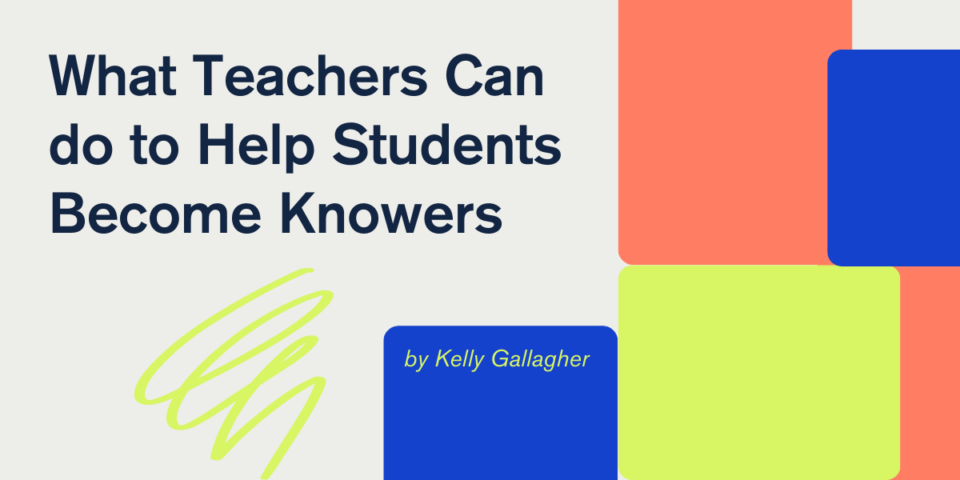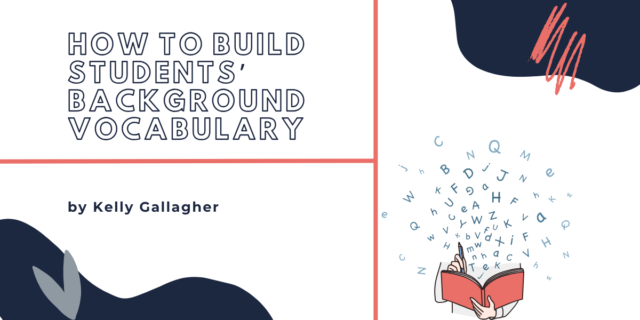
The following is an excerpt from To Read Stuff You Have to Know Stuff: Helping Students Build and Use Prior Knowledge by Kelly Gallagher, who taught English at Magnolia High School in Anaheim, CA for 35 years.
Our general ability to learn is highly correlated with general knowledge. The more you know about baseball, or music, or math, the more you are able to learn about baseball, or music, or math. In fact, the correlation between having general knowledge and learning was found to be twice as high as the correlation attributed to socioeconomic status (Lubinski and Humphreys 1997). Your ability to learn rests largely on what you already know, regardless of your background.
I was reminded of this yesterday when I met with a group of students who were reading Clint Smith’s How the Word Is Passed, a thought-provoking tour of many of the nation’s historical sites in which Smith probes the untold history of each place. The students, who were halfway through the book, were struggling. Through conferring with them, I realized that much of their confusion and disconnection was rooted in their lack of prior knowledge. Not only had the students never visited any of the sites, but they had never heard of them. This unfamiliarity not only made the reading much more difficult but also contributed to them questioning why they had to study any of these landmarks in the first place.1
Alberto Manguel, author of A History of Reading, reminds us, “Everything proceeds in geometric progression based on what is known and what is remembered every time we read something new” (cited in Wolf 2019, 88). These students lacked the general historical knowledge that would have helped them make important connections. “Geometric progression” was not possible. It is difficult to think deeply about something you know nothing about.
Having knowledge not only helps you learn more but also fuels your curiosity. As Ian Leslie, author of Curious, notes, curiosity “is stimulated by understanding and by the absence of understanding” (2015, 36). If you know nothing about a subject—say neoclassical architecture, for example—you are unlikely to want to discuss it. But if you already know something about the topic at hand, you are much more likely to be curious. Leslie says, “The more we know about something, the more intense our curiosity is about what we don’t know” (38). Curiosity is generated, he says, when we find ourselves in the “curiosity zone”—that place where we have some knowledge but not too much knowledge (38). Leslie rejects the notion that some students are more curious than others; instead, what really matters is the context in which students encounter new information. Not having any context creates indifference.
Students who know a lot learn more, and they are more likely to widen their curiosity, which also brings them to another benefit: they develop the ability to think at deeper levels. Consider those whom we consider experts. In How People Learn, the National Research Council notes that experts, regardless of the field, always draw on a richly structured information base; they are not just “good thinkers” or “smart people.” The ability to plan a task, to notice patterns, to generate reasonable arguments and explanations, and to draw analogies to other problems are also more closely intertwined with factual knowledge than what was once believed. (Bransford, Brown, and Cocking 2000, 14)
Good thinkers have built a reservoir of knowledge. Tom Loveless, a senior fellow in the Governance Studies program at the Brookings Institution, echoes this notion: “One of the most highly replicated findings of education research is that a good predictor of how much students will learn tomorrow is how much they know today. Studies of interventions that simply ratchet up expectations without regard for students’ prior knowledge have yielded disappointing results” (2021; italics mine).
There is a lot at stake here. Maryanne Wolf, expert in cognitive neurosciences, worries that we rely too much on external knowledge at the expense of not building internal knowledge. Doing so would affect our ability to think critically, leading us to “become increasingly susceptible human beings who are more and more easily led by sometimes dubious, sometimes even false information that we mistake for knowledge, or, worse, do not care one way or another” (2019, 55). When we don’t own our knowledge, we are put in a precarious position wherein we are forced to rely on others to do our thinking for us.2
Building this internal knowledge is critical, and the earlier, the better. Daniel Willingham (2012) reminds us, “Once kids are fluent decoders, much of the difference among readers is not due to whether they’re a ‘good reader’ or a ‘bad reader’ (meaning they have good or bad reading skills). Much of the difference among readers is due to how wide a range of knowledge they have.” This bears repeating: much of the difference between “good” and “bad” readers is strongly correlated with the amount of knowledge they possess. It is important to teach students the moves good readers make, but we must not lose sight of the fact that these moves are contingent on the reader knowing things.3
So what can teachers do to help students become knowers? Here are ten suggestions.
- Explain the importance of prior knowledge. Most students do not understand the value of prior knowledge. Teach the importance early in the year. Start with political cartoons and memes in which they can read the words but don’t have enough context to make sense of what they are reading. Work up to passages and articles. Explain to students that one cannot think deeply, or argue a serious point, without owning knowledge on the topic. Remind them that how much they will learn in the future will depend largely on how much they know.
- Teach students that confusion is normal, especially when you lack prior knowledge. Confusion is often rooted in not knowing enough about the topic. Teach students to embrace confusion instead of being afraid of it. Confusion is an opportunity to learn, and the more you learn, the less confusing things become. Model how you work through your confusion when reading, and show students how you connect to prior knowledge to work through your confusion.
- Teach students the value of long reading. Books uniquely provide readers with deeper knowledge (as opposed to passage study or click-and-go reading). Give students time to read in class, and as the year progresses, stretch that time out. Help them to develop a quiet eye. Make it a goal that students will be able to sit and read for an uninterrupted hour by the end of the school year—a far stretch for those students who begin the year suffering from distraction addiction. State this goal at the beginning of the year and work toward it.
- Balance the reading diet. Move away from teaching only the classics. Find books that are tuned in to the students. Give them choices. In their study of four hundred students, Ivey and Johnston (2023) found that when students had choice and access to books they were interested in, their volume of reading took off and their reading achievement greatly improved. There is important knowledge to be gleaned from self-selected books. For example, when some of my students read We Are Not from Here—not a core work—they gained a lot of knowledge about the plight of refugees.
- Make volume a top priority. It will not matter how many standards you teach if students are not reading. Make the elimination of fake reading a top priority. Remember, the more balanced the reading diet, the more likely students will read, and the more they read, the more knowledge they will acquire. Have students complete a log of books they’ve read (and abandoned). The number of books a student reads is a strong indicator of success throughout K–12 and beyond.
- Surround them with books they want to read. Building a classroom library is a career-long project. I was still building mine in my thirty-fifth year. Yes, there is value in taking your students to the school library—and I hope you do—but there is also power in giving students immediate daily access to good books in the classroom. Book readers build deeper knowledge. To make that happen, students need daily access to books that interest them. Conduct daily book talks to entice them.
- Give them time to read in school. As my friend Penny Kittle says, “If students are not reading with you, they are not reading without you”—another reason to devote some class time to reading. In 180 Days (Gallagher and Kittle 2018), we write about how we devoted the first ten minutes of every class period to in-class reading, and while students were reading, we conducted one-on-one reading conferences. This personal interaction with each student is the key to breaking the fake reading habit. Never lose sight of volume, volume, volume.
- Ditch the vocabulary quizzes, but teach word-attack skills. Time spent on weekly vocabulary lists would be better spent by having students read. There is a value, however, in teaching students knowledge about how words are constructed. Teach them the common prefixes, roots, and suffixes. Model what you do when confronted with an unfamiliar word. Again, a volume of reading is critical to overcoming word poverty. Deeper thinking is very difficult when one’s vocabulary is limited. Restricted knowledge of words restricts thinking and makes learning harder.
- Find the sweet spot of framing. The most difficult novel to teach is often the one that is farthest away from the students’ prior knowledge. Often the framing you do before students read plays a critical role in their comprehension and thus motivation. Constantly ask yourself key questions: How much framing do they need? How much is not enough? How much is too much? Where’s the tipping point between helping and enabling? What can I do to ensure students will keep reading?
- Assign an article of the week regularly. We are not literature teachers; we are literacy teachers. Choose weekly articles that will inform students (which is not the same as picking articles that will entertain them). Lure them out of their entertainment bubbles. Annotate an article in front of the students, modeling your thinking as you do so. Stop at least once a quarter and remind students why you are asking them to read these weekly articles (see tip 1 in this list). Revisit their importance when enthusiasm lags
1. Having students read books that are completely unfamiliar to them is not necessarily a bad thing. But it is a hard thing. It requires careful front-loading (as discussed in the last chapter) and other means of support from the teacher, especially in a classroom of students who are largely unmotivated readers.
2.Exhibit A: Since Wolf wrote that passage, we now live in a society where nearly one-third of Americans still wrongly believe that the results of the 2020 presidential election were fraudulent (Kamisar 2023).
3.Knowledgeable readers not only read better but are likely to develop the ability to read faster, as knowing things cuts down on the need to reread things that are unfamiliar (Willingham 2021).



